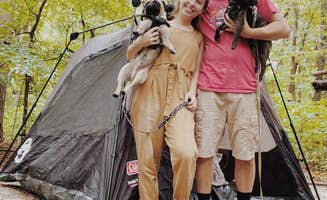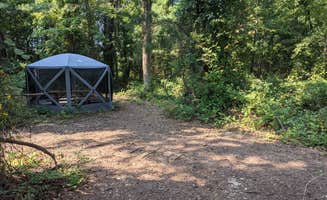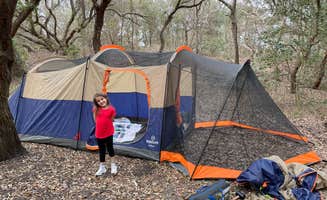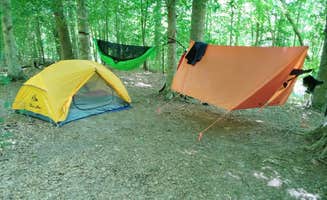Tent camping near Hampton, Virginia offers several off-the-beaten-path options within the coastal plain region where elevation rarely exceeds 100 feet above sea level. The coastal climate creates warm, humid camping conditions from May through September, with frequent afternoon thunderstorms during summer months. Water access is a defining feature of many camping areas, with several sites positioned around lakes, bays or the Atlantic Ocean.
What to do
Kayaking and boating: Sandy Bottom Nature Park provides accessible water activities on its small lake. "To kayak here it's the bomb!" reports Susan P., while multiple visitors mention boat rentals for those without personal watercraft. The park offers both kayaks and paddle boats available by the hour.
Wildlife viewing: Coastal Virginia camping areas host diverse ecosystems. At False Cape State Park, campers regularly spot dolphins, shore birds, and other coastal wildlife. One visitor noted, "We saw dolphins playing in the ocean! The beach alive with crabs! Osprey catching fish!" The park's remote location creates excellent wildlife viewing opportunities.
Fishing: Multiple camping areas support fishing activities. At Merchants Millpond in nearby North Carolina, unusual species await. As one camper described, "One of my kids caught a gar, we saw a bald eagle's nest, snakes, frogs, turtles, and lily pads everywhere." Sandy Bottom Nature Park also offers fishing opportunities in its small lake with abundant turtles.
What campers like
Beach access: Wisteria Beach Hideaway sits near several different beaches with natural surroundings. "The beaches were surrounded by pine, wetlands, and tall grasses - it felt remote and not overdeveloped!" writes one camper. These less-crowded beach spots provide alternatives to busier Virginia Beach.
Natural seclusion: Many tent campers appreciate the quiet settings available at parks like False Cape. "Because of this, the Park is a serene oasis away from traffic, no RV's, not a lot of people. A great place to get away from it all!" wrote one visitor. Another camper mentioned, "Really there wasn't hardly anyone else out there, so it felt like we had our own private beach."
Amenities at primitive sites: Campers appreciate small comforts that enhance primitive camping experiences. At Wisteria Beach Hideaway, "The bug screen and hammock that are part of the site was so appreciated. Also, having a shower was great - it felt like we were glamping!" Another camper noted the site's "swinging grill grate on the firepit, which was great for camp pizzas!"
What you should know
Access challenges: Many camping areas require significant effort to reach. Merchants Millpond Canoe-In Campground requires water navigation, and one camper warns, "The kayak/canoe round was not easy to navigate so bring your 3rd party map/GPS. The maps they provide are almost useless because it's a swamp the terrain changes with the water level."
Bug preparations: Insects present challenges at most camping areas. At False Cape State Park, campers advise, "Bring bug spray--we went in May and the bugs were already overwhelming--including many, many ticks." At Wisteria Beach Hideaway, "Due to a lack of wind, flies were bad on the beach. I would recommend bringing an insect screen if you have it."
Reservations and timing: At Sandy Bottom Nature Park, "Sites are first come, first served. Must reserve in person. Visitor's center is open 9-6." False Cape camping requires even more advance planning due to the trek required, with most campers reserving well ahead during peak seasons.
Tips for camping with families
Bike-in camping options: Bennetts Creek Canoe-In Campground offers an adventure opportunity for families with older children. "My group and I stayed at the Benett's creek high ground primitive camp sites 1-3. It was a 4.5 mile paddle to the site," reports one camper. False Cape State Park is also accessible by bike, with one family noting, "We biked in from Little Island Park. From the parking lot to our campsite, it was about 7.5 miles."
Kid-friendly activities: Sandy Bottom offers trails and wildlife viewing suitable for children. "Lots of hiking trails to walk & turtles in the lake!! Plus you can rent boats for a cheap price which we will probably go back to do," reports one visitor. The nature center also provides educational opportunities for children.
Pack strategically: When tent camping with children at False Cape, families recommend careful planning. "We're both in good shape, and on bike we made the trek in less than an hour. I rode my mountain bike, and my wife road her hybrid commuter bike without issue. We brought a collapsible 5 gallon jug that I had to ride back to the visitors center (about 2 miles from our campsite) to fill up."
Tips from RVers
Limited options: Carter's Cove Campground offers some RV camping but receives mixed reviews. One camper notes, "More of a long term stay but there are a few spots for RV's. Laundry, trash, restrooms, picnic table, fire pit (day use only). Mature trees and over all space is very large. Sites are level with some spacing."
Consider state park alternatives: Most tent camping destinations near Hampton don't accommodate RVs due to access restrictions. False Cape State Park explicitly prohibits RVs as one camper noted, "A great place to get away from it all! We hiked in on the East Dike trail through Back Bay, about 5.4 miles, with everything for the weekend on our backs."





